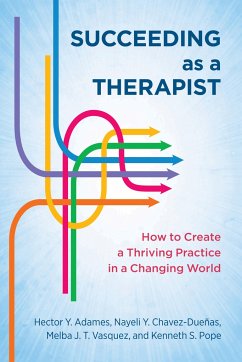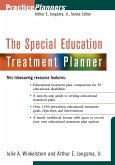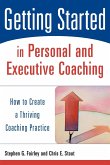Hector Y Adames, Nayeli Y Chavez-Dueñas, Melba J T Vasquez, Kenneth S Pope
Succeeding as a Therapist
How to Create a Thriving Practice in a Changing World
Hector Y Adames, Nayeli Y Chavez-Dueñas, Melba J T Vasquez, Kenneth S Pope
Succeeding as a Therapist
How to Create a Thriving Practice in a Changing World
- Broschiertes Buch
- Merkliste
- Auf die Merkliste
- Bewerten Bewerten
- Teilen
- Produkt teilen
- Produkterinnerung
- Produkterinnerung
This user-friendly, practical guide summarizes everything therapists need to know about setting up, growing, and protecting their independent therapy practice.
Andere Kunden interessierten sich auch für
![Essential Ethics for Psychologists Essential Ethics for Psychologists]() Thomas F NagyEssential Ethics for Psychologists69,99 €
Thomas F NagyEssential Ethics for Psychologists69,99 €![A Guide to Possibility Land A Guide to Possibility Land]() Sandy BeadleA Guide to Possibility Land22,99 €
Sandy BeadleA Guide to Possibility Land22,99 €![The Therapist's Advertising and Marketing Kit (Book ) The Therapist's Advertising and Marketing Kit (Book )]() Laurie C GrandThe Therapist's Advertising and Marketing Kit (Book )78,99 €
Laurie C GrandThe Therapist's Advertising and Marketing Kit (Book )78,99 €![The Special Education Treatment Planner The Special Education Treatment Planner]() Julie a WinkelsternThe Special Education Treatment Planner76,99 €
Julie a WinkelsternThe Special Education Treatment Planner76,99 €![Getting Started in Personal and Executive Coaching Getting Started in Personal and Executive Coaching]() Stephen G FairleyGetting Started in Personal and Executive Coaching65,99 €
Stephen G FairleyGetting Started in Personal and Executive Coaching65,99 €![Addiction Treatment Homework Planner Addiction Treatment Homework Planner]() Addiction Treatment Homework Planner71,99 €
Addiction Treatment Homework Planner71,99 €![The Creative Therapist in Practice The Creative Therapist in Practice]() Hillary KeeneyThe Creative Therapist in Practice55,99 €
Hillary KeeneyThe Creative Therapist in Practice55,99 €-
-
-
This user-friendly, practical guide summarizes everything therapists need to know about setting up, growing, and protecting their independent therapy practice.
Hinweis: Dieser Artikel kann nur an eine deutsche Lieferadresse ausgeliefert werden.
Hinweis: Dieser Artikel kann nur an eine deutsche Lieferadresse ausgeliefert werden.
Produktdetails
- Produktdetails
- Verlag: American Psychological Association (APA)
- Seitenzahl: 341
- Erscheinungstermin: 27. September 2022
- Englisch
- Abmessung: 234mm x 153mm x 18mm
- Gewicht: 503g
- ISBN-13: 9781433840036
- ISBN-10: 1433840030
- Artikelnr.: 64056535
- Verlag: American Psychological Association (APA)
- Seitenzahl: 341
- Erscheinungstermin: 27. September 2022
- Englisch
- Abmessung: 234mm x 153mm x 18mm
- Gewicht: 503g
- ISBN-13: 9781433840036
- ISBN-10: 1433840030
- Artikelnr.: 64056535
Hector Y. Adames, PsyD, received his doctorate in Clinical Psychology from Wright State University in Ohio and completed his pre-doctoral internship at the Boston University School of Medicine's Center for Multicultural Training in Psychology (CMTP). Currently, he is a licensed psychologist and a Professor at The Chicago School of Professional Psychology, Chicago Campus and the Co-Director of the IC-RACE Lab (Immigration Critical Race and Cultural Equity Lab). He has earned several awards including the 2018 Distinguished Emerging Professional Research Award from The Society for the Psychological Study of Culture, Ethnicity, and Race, a Division of the American Psychological Association. Follow Dr. Adames on Twitter, Instagram, or visit the IC-RACE Lab. Nayeli Y. Chavez-Dueñas, PhD, received her doctorate in Clinical Psychology from Southern Illinois University at Carbondale. She is a Professor at The Chicago School of Professional Psychology (TCSPP) where she serves as the faculty coordinator for the concentration in Latinx Mental Health in the Counseling Psychology Department. She is the Co-Director of the IC-RACE Lab (Immigration Critical Race and Cultural Equity Lab). Her research focuses on colorism, skin-color differences, parenting styles, immigration, unaccompanied minors, multiculturalism, and race relations. She has earned a number of awards including the 2018 American Psychological Association (APA) Distinguished Citizen Psychologist Award. Follow Dr. Chavez-Dueñas on Twitter, Instagram, or visit the IC-RACE Lab. Melba J.T. Vasquez, PhD, ABPP, is in independent practice in Austin, Texas. She served as President of the American Psychological Association in 2011 and is the first Latina and Woman of Color of 120 presidencies of APA to serve in that role. Dr. Vasquez also served a term on the APA Board of Directors. She obtained her doctorate in counseling psychology from the University of Texas at Austin in 1978. She is a coauthor of a book, Multicultural Therapy: A Practice Imperative, and is coauthor of six editions of Ethics in Psychotherapy and Counseling: A Practical Guide. Dr. Vasquez has also published about 100 book chapters and journal articles in the areas of professional ethics, ethnic minority psychology, psychology of women, counseling and psychotherapy, and leadership. She has served on numerous editorial boards. Kenneth S. Pope, PhD, ABPP, is a licensed psychologist. A Fellow of the Association for Psychological Science (APS), he served as chair of the Ethics Committees of the American Board of Professional Psychology and the American Psychological Association (APA). He received the APA Award for Distinguished Contributions to Public Service, the APA Division 12 Award for Distinguished Professional Contributions to Clinical Psychology, the Canadian Psychological Association's John C. Service Member of the Year Award, and the Ontario Psychological Association's Barbara Wand Award for significant contribution to excellence in professional ethics and standards. To learn more about Dr. Pope's work, visit https://kspope.com/.
Preface
Our Personal Journeys
Acknowledgments
Part I. INITIAL PREPARATION
1. Creating a Practice That Matches You, Your Values, and Your Vision
2. Creating a Realistic Business Plan
3. Finding the Right Attorney
4. Finding the Right Professional Liability Insurance
5. Finding the Right Office
6. Finding the Right Accountant
7. Finding the Right Software and System for Scheduling, Billing, Forms,
Client Communication, and Documentation
Part II. FINDING CLIENTS AND HELPING CLIENTS FIND YOU
8. Creating a Website, Business Cards, and Stationery
9. Advertising Ethically, Efficiently, Effectively, and Economically
10. Getting Onto Insurance Panels—But Do You Want to Do That?
11. Building and Maintaining a Presence on Social Media
Part III. RECORDS
12. Creating a Thoughtful and Useful Client Record
13. Privacy, Confidentiality, and Privilege
14. Responding to a Subpoena and Dealing With Law Enforcement
Part IV. PREPARING FOR URGENT AND EMERGENCY SITUATIONS
15. Office Safety Measures and Precautions
16. Suicide Risk
17. Clients Who Pose a Risk of Danger to a Third Party
18. Assessing and Responding to Interpersonal Violence
19. Reporting Child Abuse and Reasonable Suspicions of Child Abuse
20. Assessing and Responding to Possible Abuse of Older, Vulnerable, and
Dependent Adults and Adults With Disabilities
21. When the Therapist Is Stalked, Targeted, or Threatened by a Client or
Someone in the Client’s Life
Part V. TAKING CARE OF YOURSELF AND YOUR PRACTICE
22. Keys to Thinking Clearly and Making Good Decisions About Your Practice
23. Eight Common Missteps That Can Lead to Disaster
24. Navigating Boundaries
25. Addressing the Hazards of Loneliness
26. Addressing the Hazards of Vicarious Trauma
27. Navigating and Nourishing Personal Relationships
28. Asking for Help When We Need It
29. Creating a Practice Grounded in Human Rights
30. Creating, Embracing, and Serving Communities
31. Applying for American Board of Professional Psychology Certification
Part VI. MANAGING THE (SOMETIMES) UNEXPECTED
32. When the Therapist Becomes Pregnant
33. When the Therapist Becomes Ill
34. What to Do When You’ve Made an Error
35. What to Do (and Not Do) When Facing an Ethics, Licensing, or
Malpractice Complaint
Part VII. ENDINGS—PLANNED AND UNPLANNED
36. Successful, Unsuccessful, and Incomplete Terminations
37. Closing or Selling a Practice
38. Creating a Useful Professional Will
Afterword: Creating Our Dream Practice in a Changing World
Resource A: Professional Guidelines Relevant to Practitioners
Resource B: The Clinical Interview With Immigrants
Resource C: Strategies for Private Practitioners Coping With Subpoenas or
Compelled Testimony for Client/Patient Records or Test Data or Test
Materials
Resource D: Sample Professional Will Published by the American
Psychological Association
Resource E: Information for Professional Executors: Files, Passwords, and
Contacts List
Resource F: The No Surprises Act: Frequently Asked Questions and Responses
References
Index
About the Authors
Our Personal Journeys
Acknowledgments
Part I. INITIAL PREPARATION
1. Creating a Practice That Matches You, Your Values, and Your Vision
2. Creating a Realistic Business Plan
3. Finding the Right Attorney
4. Finding the Right Professional Liability Insurance
5. Finding the Right Office
6. Finding the Right Accountant
7. Finding the Right Software and System for Scheduling, Billing, Forms,
Client Communication, and Documentation
Part II. FINDING CLIENTS AND HELPING CLIENTS FIND YOU
8. Creating a Website, Business Cards, and Stationery
9. Advertising Ethically, Efficiently, Effectively, and Economically
10. Getting Onto Insurance Panels—But Do You Want to Do That?
11. Building and Maintaining a Presence on Social Media
Part III. RECORDS
12. Creating a Thoughtful and Useful Client Record
13. Privacy, Confidentiality, and Privilege
14. Responding to a Subpoena and Dealing With Law Enforcement
Part IV. PREPARING FOR URGENT AND EMERGENCY SITUATIONS
15. Office Safety Measures and Precautions
16. Suicide Risk
17. Clients Who Pose a Risk of Danger to a Third Party
18. Assessing and Responding to Interpersonal Violence
19. Reporting Child Abuse and Reasonable Suspicions of Child Abuse
20. Assessing and Responding to Possible Abuse of Older, Vulnerable, and
Dependent Adults and Adults With Disabilities
21. When the Therapist Is Stalked, Targeted, or Threatened by a Client or
Someone in the Client’s Life
Part V. TAKING CARE OF YOURSELF AND YOUR PRACTICE
22. Keys to Thinking Clearly and Making Good Decisions About Your Practice
23. Eight Common Missteps That Can Lead to Disaster
24. Navigating Boundaries
25. Addressing the Hazards of Loneliness
26. Addressing the Hazards of Vicarious Trauma
27. Navigating and Nourishing Personal Relationships
28. Asking for Help When We Need It
29. Creating a Practice Grounded in Human Rights
30. Creating, Embracing, and Serving Communities
31. Applying for American Board of Professional Psychology Certification
Part VI. MANAGING THE (SOMETIMES) UNEXPECTED
32. When the Therapist Becomes Pregnant
33. When the Therapist Becomes Ill
34. What to Do When You’ve Made an Error
35. What to Do (and Not Do) When Facing an Ethics, Licensing, or
Malpractice Complaint
Part VII. ENDINGS—PLANNED AND UNPLANNED
36. Successful, Unsuccessful, and Incomplete Terminations
37. Closing or Selling a Practice
38. Creating a Useful Professional Will
Afterword: Creating Our Dream Practice in a Changing World
Resource A: Professional Guidelines Relevant to Practitioners
Resource B: The Clinical Interview With Immigrants
Resource C: Strategies for Private Practitioners Coping With Subpoenas or
Compelled Testimony for Client/Patient Records or Test Data or Test
Materials
Resource D: Sample Professional Will Published by the American
Psychological Association
Resource E: Information for Professional Executors: Files, Passwords, and
Contacts List
Resource F: The No Surprises Act: Frequently Asked Questions and Responses
References
Index
About the Authors
Preface
Our Personal Journeys
Acknowledgments
Part I. INITIAL PREPARATION
1. Creating a Practice That Matches You, Your Values, and Your Vision
2. Creating a Realistic Business Plan
3. Finding the Right Attorney
4. Finding the Right Professional Liability Insurance
5. Finding the Right Office
6. Finding the Right Accountant
7. Finding the Right Software and System for Scheduling, Billing, Forms,
Client Communication, and Documentation
Part II. FINDING CLIENTS AND HELPING CLIENTS FIND YOU
8. Creating a Website, Business Cards, and Stationery
9. Advertising Ethically, Efficiently, Effectively, and Economically
10. Getting Onto Insurance Panels—But Do You Want to Do That?
11. Building and Maintaining a Presence on Social Media
Part III. RECORDS
12. Creating a Thoughtful and Useful Client Record
13. Privacy, Confidentiality, and Privilege
14. Responding to a Subpoena and Dealing With Law Enforcement
Part IV. PREPARING FOR URGENT AND EMERGENCY SITUATIONS
15. Office Safety Measures and Precautions
16. Suicide Risk
17. Clients Who Pose a Risk of Danger to a Third Party
18. Assessing and Responding to Interpersonal Violence
19. Reporting Child Abuse and Reasonable Suspicions of Child Abuse
20. Assessing and Responding to Possible Abuse of Older, Vulnerable, and
Dependent Adults and Adults With Disabilities
21. When the Therapist Is Stalked, Targeted, or Threatened by a Client or
Someone in the Client’s Life
Part V. TAKING CARE OF YOURSELF AND YOUR PRACTICE
22. Keys to Thinking Clearly and Making Good Decisions About Your Practice
23. Eight Common Missteps That Can Lead to Disaster
24. Navigating Boundaries
25. Addressing the Hazards of Loneliness
26. Addressing the Hazards of Vicarious Trauma
27. Navigating and Nourishing Personal Relationships
28. Asking for Help When We Need It
29. Creating a Practice Grounded in Human Rights
30. Creating, Embracing, and Serving Communities
31. Applying for American Board of Professional Psychology Certification
Part VI. MANAGING THE (SOMETIMES) UNEXPECTED
32. When the Therapist Becomes Pregnant
33. When the Therapist Becomes Ill
34. What to Do When You’ve Made an Error
35. What to Do (and Not Do) When Facing an Ethics, Licensing, or
Malpractice Complaint
Part VII. ENDINGS—PLANNED AND UNPLANNED
36. Successful, Unsuccessful, and Incomplete Terminations
37. Closing or Selling a Practice
38. Creating a Useful Professional Will
Afterword: Creating Our Dream Practice in a Changing World
Resource A: Professional Guidelines Relevant to Practitioners
Resource B: The Clinical Interview With Immigrants
Resource C: Strategies for Private Practitioners Coping With Subpoenas or
Compelled Testimony for Client/Patient Records or Test Data or Test
Materials
Resource D: Sample Professional Will Published by the American
Psychological Association
Resource E: Information for Professional Executors: Files, Passwords, and
Contacts List
Resource F: The No Surprises Act: Frequently Asked Questions and Responses
References
Index
About the Authors
Our Personal Journeys
Acknowledgments
Part I. INITIAL PREPARATION
1. Creating a Practice That Matches You, Your Values, and Your Vision
2. Creating a Realistic Business Plan
3. Finding the Right Attorney
4. Finding the Right Professional Liability Insurance
5. Finding the Right Office
6. Finding the Right Accountant
7. Finding the Right Software and System for Scheduling, Billing, Forms,
Client Communication, and Documentation
Part II. FINDING CLIENTS AND HELPING CLIENTS FIND YOU
8. Creating a Website, Business Cards, and Stationery
9. Advertising Ethically, Efficiently, Effectively, and Economically
10. Getting Onto Insurance Panels—But Do You Want to Do That?
11. Building and Maintaining a Presence on Social Media
Part III. RECORDS
12. Creating a Thoughtful and Useful Client Record
13. Privacy, Confidentiality, and Privilege
14. Responding to a Subpoena and Dealing With Law Enforcement
Part IV. PREPARING FOR URGENT AND EMERGENCY SITUATIONS
15. Office Safety Measures and Precautions
16. Suicide Risk
17. Clients Who Pose a Risk of Danger to a Third Party
18. Assessing and Responding to Interpersonal Violence
19. Reporting Child Abuse and Reasonable Suspicions of Child Abuse
20. Assessing and Responding to Possible Abuse of Older, Vulnerable, and
Dependent Adults and Adults With Disabilities
21. When the Therapist Is Stalked, Targeted, or Threatened by a Client or
Someone in the Client’s Life
Part V. TAKING CARE OF YOURSELF AND YOUR PRACTICE
22. Keys to Thinking Clearly and Making Good Decisions About Your Practice
23. Eight Common Missteps That Can Lead to Disaster
24. Navigating Boundaries
25. Addressing the Hazards of Loneliness
26. Addressing the Hazards of Vicarious Trauma
27. Navigating and Nourishing Personal Relationships
28. Asking for Help When We Need It
29. Creating a Practice Grounded in Human Rights
30. Creating, Embracing, and Serving Communities
31. Applying for American Board of Professional Psychology Certification
Part VI. MANAGING THE (SOMETIMES) UNEXPECTED
32. When the Therapist Becomes Pregnant
33. When the Therapist Becomes Ill
34. What to Do When You’ve Made an Error
35. What to Do (and Not Do) When Facing an Ethics, Licensing, or
Malpractice Complaint
Part VII. ENDINGS—PLANNED AND UNPLANNED
36. Successful, Unsuccessful, and Incomplete Terminations
37. Closing or Selling a Practice
38. Creating a Useful Professional Will
Afterword: Creating Our Dream Practice in a Changing World
Resource A: Professional Guidelines Relevant to Practitioners
Resource B: The Clinical Interview With Immigrants
Resource C: Strategies for Private Practitioners Coping With Subpoenas or
Compelled Testimony for Client/Patient Records or Test Data or Test
Materials
Resource D: Sample Professional Will Published by the American
Psychological Association
Resource E: Information for Professional Executors: Files, Passwords, and
Contacts List
Resource F: The No Surprises Act: Frequently Asked Questions and Responses
References
Index
About the Authors







